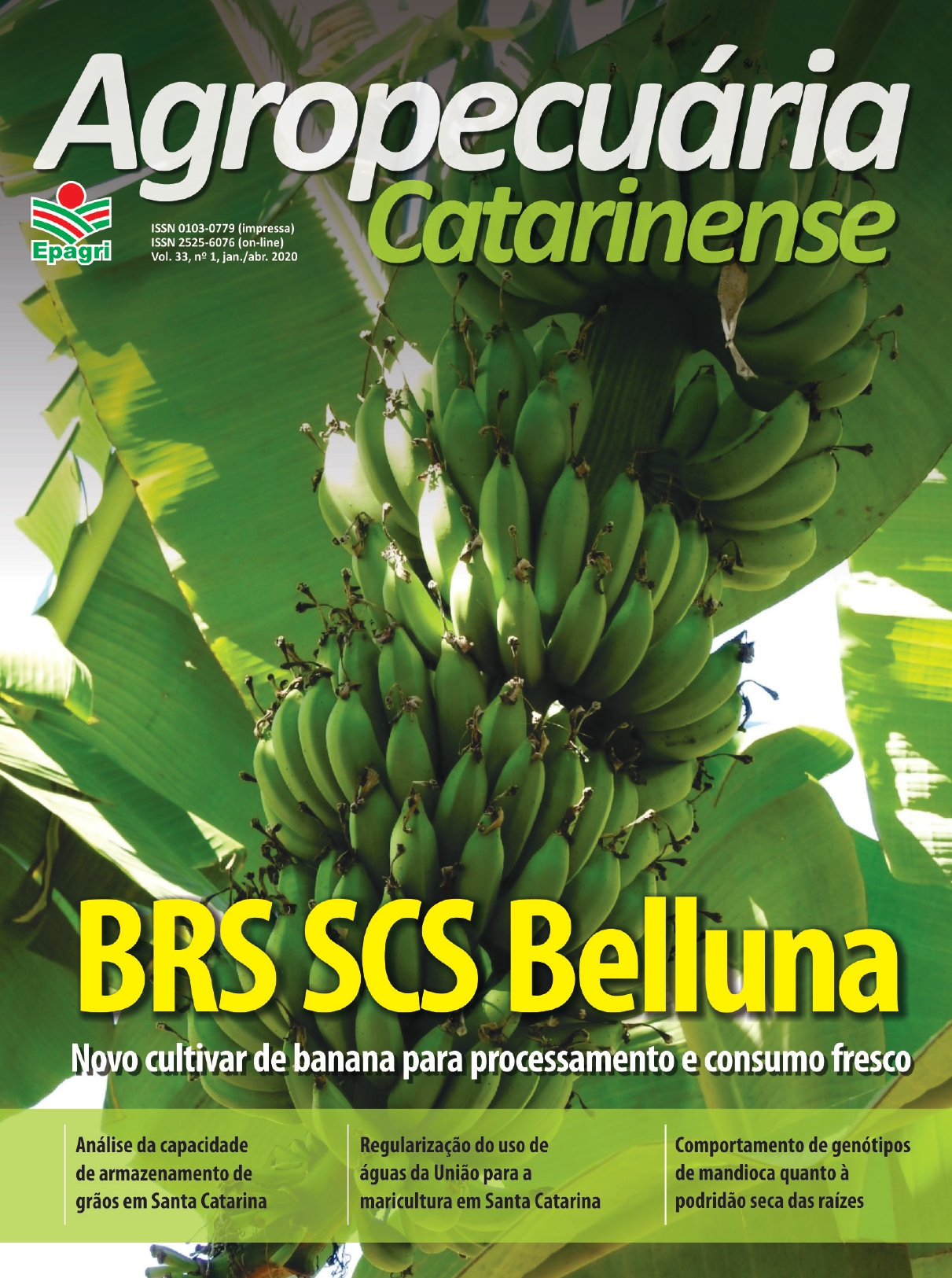Fitase e seus efeitos extra fosfóricos em dietas para frangos de corte: revisão
DOI:
https://doi.org/10.52945/rac.v33i1.491Palabras clave:
desempenho, enzimas exógenas, fosforo inorgânicoResumen
As dietas para aves são compostas principalmente por produtos de origem vegetal, em que a maior parte do fosforo (P) se encontra na forma indisponível, denominada fitato. A molécula de fitato e os nutrientes ligados a ela não podem ser absorvidos no trato digestivo sem degradação enzimática realizada pelas fitases. As fitases hidrolisam o fitato em uma molécula de inositol e seis moléculas inorgânicas de fosfato reduzindo os seus efeitos antinutricionais. A magnitude da resposta da fitase pode ser mais significativa com o aumento dos níveis de inclusão e a degradação do fitato se correlaciona com grandes aumentos na retenção de P, concentração de cinzas na tíbia, ganho de peso, consumo de ração, eficiência alimentar, retenção de nitrogênio, energia metabolizável aparente e retenção de Ca. Por isso, esta revisão tem o objetivo de caracterizar a fitase e abordar os aspectos relacionados na sua eficácia e seus efeitos extra fosfóricos em dietas para frangos de corte.
Métricas
Publication Facts
Reviewer profiles N/D
Author statements
- Academic society
- Epagri - Revista Agropecuária Catarinense
- Editora:
- Empresa de Pesquisa Agropecuária e Extensão Rural de Santa Catarina - Epagri
Citas
ADEDOKUN, S.A.; ADEOLA, O. Calcium and phosphorus digestibility: Metabolic limits. Journal Applied Poultry Research, Champaign, v.22, n.3, p 600-608, 2013.
AOAC, Method 2000.12: Phytase activity in feed: colorimetric enzymatic method, in Official Methods of Analysis of AOAC International (17th edn). Association of Official Analytical Chemists, Arlington, VA, 2000.
ANSELME, P. Considerations on the use of microbial phytase. CEFIC. Inorganic Feed Phosphates, Brussels. 2006.
BEDFORD, M.R.; CHOCT, M.; O'NEILL, H.M. Nutrition Experiments in Pigs and Poultry: A Practical Guide. In; Pesti, G.M.; Althon, R.A.; Da Costa, M.J.; Billard, L. Most common designs and understanding their limits. Boston: CABI, 2016. 178p.
BONEY, J.W.; MORITZ, J.S. Phytase dose effects in practically formulated diets that vary in ingredient composition on feed manufacturing and broiler performance. Journal of Applied Poultry Research, Champaign, v.26, n.2, p.273-285, 2017.
COWIESON, A.J.; AURELI, R.; GUGGENBUHL, P.; FRU-NJI, F. Possible involvement of myo-inositol in the physiological response of broilers to high doses of microbial phytase. Animal Production Science, Clayton South, v.55, n.6, p.710-719, 2015.
DERSJANT-LI, Y.; AWATI, A.; SCHULZE, H.; PARTRIDGE, G. Phytase in non-ruminant animal nutrition: a critical review on phytase activities in the gastrointestinal tract and influencing factors. Journal of the Science of Food and Agriculture, v.95, n.5, p.878-896, 2015.
DRIVER, J.P.; PESTI, G.M.; BAKALLI, R.I.; EDWARDS JR., H.M. The effect of feeding calcium-and phosphorus-deficient diets to broiler chickens during the starting and growing-finishing phases on carcass quality. Poultry Science, Champaign, v.85, n. 11, p.1939-1946, 2006.
GUPTA, R.K.; GANGOLIYA, S.S.; Singh, N.K. Reduction of phytic acid and enhancement of bioavailable micronutrients in food grains. Journal of Food Science and Technology, Campinas, v.52, n.2, p.676-684, 2015.
GREINER, R. AND KONIETZNY, U. Phytase for food application. Food Technology and Biotechnology, Zagreb, v.44, n.2, p.123-140, 2006.
KACZMAREK, S.A.; COWIESON, A.J.; HEJDYSZ, M.; RUTKOWSKI, A. Microbial phytase improves performance and bone traits in broilers fed diets based on soybean meal and containing lupin meal. Animal Production Science, Clayton South, v.56, n.10, p.1669-1676, 2016.
KORNEGAY, E.T. Digestion of phosphorus and other nutrients: the role of phytases and factors influencing their activity. Enzymes in farm animal nutrition, 2001. 237-271p.
LEI, X.G.; STAHL, C.H. Nutritional benefits of phytase and dietary determinants of its efficacy. Journal of Applied Animal Research, Champaign, v.17, n.1, p.97-112, 2000.
MUNIR, K.; MAQSOOD, S. A review on role of exogenous enzyme supplementation in poultry production. Journal of Food and Agriculture, Abu Dhabi, v.25, n.1, p.66-80, 2013.
NISSAR, J.; AHAD, T.; NAIK, H.R.; HUSSAIN, S.Z. A review phytic acid: As antinutrient or nutraceutical. Journal of Pharmacognosy and Phytochemistry, Rohini, v.6, n.6, p.1554-1560, 2017.
OLUKOSI, O.A. Biochemistry of phytate and phytases: Applications in monogastric nutrition. Journal of the Nigerian Society for Experimental Biology, Makhanda, v.24, n.2, p.58-63, 2013.
PALLAUF, J.; RIMBACH, G. Nutritional significance of phytic acid and phytase. Archives of Animal Nutrition, v.50, n.4, p.301-319, 1997.
QIAN, H., VEIT, H.P., KORNEGAY, E.T., RAVINDRAN, V., AND DENBOW, D.M. Effects of supplemental phytase and phosphorus on histological and other tibial bone characteristics and performances of broilers fed semi-purified diets. Poultry Science, v.75, p.618-626, 1996.
RAVINDRAN, V. Phytases in poultry nutrition. An overview. Poultry Science, Champaign, v.7, p.135–139, 1995.
RAVINDRAN, V. Feed enzymes: The science, practice, and metabolic realities. Journal of Applied Poultry Research, Champaign, v.22, n.3, p.628-636, 2013.
SELLE, P.H.; RAVINDRAN, V. Microbial phytase in poultry nutrition. Animal Feed Science and Technology, Davis, v.135, n.1, p.1-41, 2007.
TAHIR, M.; SHIM, M.Y.; WARD, N.E.; SMITH, C.; FOSTER, E.; GUNEY, A.C.; PESTI, G.M. Phytate and other nutrient components of feed ingredients for poultry. Poultry Science, Champaign, v.91, n.4, p.928-935, 2012.
WILKINSON, S.J.; SELLE, P.H.; BEDFORD, M.R.; COWIESON, A. J. Separate feeding of calcium improves performance and ileal nutrient digestibility in broiler chicks. Animal Production Science, Clayton South, v.54, n.2, p.172-178, 2014.
WOYENGO, T.A; NYACHOTI, C.M. Review: Anti-nutritional effects of phytic acid in diets for pigs and poultry–current knowledge and directions for future research. Canadian Journal of Animal Science, Ottawa, v.93, n.1, p.9-21, 2013.






